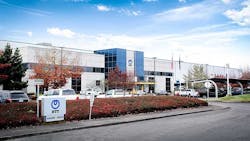Price of Power Positions Portland for Data Center Development
A new special report from Data Center Frontier explores the evolution of the Portland, Ore., data center market. This last entry in this series explores the Portland electricity options and business environment, including hazard risk, economic development, connectivity and more.
Get the full report.
Connectivity
Portland has an extensive fiber footprint available downtown and in its suburbs, due to heavy investment by Zayo, XO Communications, Windstream, CenturyLink, and Integra. Portland also lies upon several long-haul routes connecting the West Coast, from Vancouver to San Diego. Gigabit Ethernet connections are available downtown through CenturyLink. Furthermore, Portland benefits from several submarine cable routes, acting as a connectivity gateway to Australia, New Zealand, Japan, China, and South Korea. The most recent development is the Hawaiki Submarine Cable, connecting Portland, Hawaii, and Australia. The project was heavily backed by Amazon. The subsea cable landing in Pacific City connects to the Hillsboro area via a dark fiber ring from Wave Business.
Companies leverage Oregon’s lack of sales tax along with the property tax exemptions earmarked for companies that build in special tax havens called “Enterprise Zones” in Portland’s suburbs.
Power
Portland electricity costs are low, especially compared to other West Coast markets, such as Los Angeles and Silicon Valley. The primary power provider, Portland General Electric, generates power from diverse sources. A benefit of PGE is their abundance of hydroelectric power, with five owned hydroelectric plants, with an additional two plants jointly owned. Intel has been heavily involved in Portland since 1974, and has invested in building the city’s electric infrastructure. PGE has three highreliability substations in Hillsboro’s industrial district, ensuring full redundancy at each level of the power network. At 5 to 6 cents per kilowatt hour, PGE’s rates are significantly cheaper than utility power options in major California markets, and slightly more competitive than pricing in the Seattle market (although higher than rates in Quincy).
Hazard Risk
The Portland market is relatively safe, with a fairly stable climate. There is little risk of large, damaging storms, hurricanes, or tornados. As with most West Coast markets, Portland is at risk for earthquakes. Similar to Seattle, however, most earthquakes are non-damaging, with only three earthquakes recorded above a magnitude of 3.5. Portland ranks lower than California and Seattle in the number of damaging earthquakes. Although volcanos represent a small risk, Portland’s four volcanos within 50 miles is worthy of note.
Economic Development and Incentives
Companies leverage Oregon’s lack of sales tax along with the property tax exemptions earmarked for companies that build in special tax havens called “Enterprise Zones” in Portland’s suburbs. Enterprise Zones in Beaverton, Hillsboro, and The Dalles spurred the building of massive data centers in the market. CBRE ranks Portland 2nd in the nation for tax incentives, with taxes representing only 2.7% of the data center project cost, far below the average 8.7%. The lower tax rates for large data centers have been the driving force in attracting users and providers to Portland instead of other large West Coast markets. Tax breaks saved Hillsboro data centers $3.1 million in 2019 and $5.4 million in 2018, according to state records.
Explore the Portland data market further through Data Center Frontier’s new special report series. The first three articles in the series can be found below:
- Portland Emerges as the Hot Data Center Market for the Pacific Northwest
- Subsea Cables, Tech Workforce Boost Portland Data Center Market
- Supply Pipeline Positions Portland for Dramatic Data Center Growth
And see the full report,“2020 Data Center Market Overview Portland.”
About the Author



